Abstract
The recent rise of plasmonic materials for solar-to-chemical energy conversion places a focus on the mechanisms associated with charge and energy flow at the metal–molecule interface. Understanding the connection between these effects and their roles in the plasmonic excitations of adsorbed molecules has been challenging. In this Review, we strive to provide a general framework—based on the concept of electron scattering—that encompasses the most important effects at the plasmonic metal–molecule interface. First we use the model of adsorbate-induced surface resistivity to understand the chemical specificity of the electron scattering process. We then analyse two of the most prominent effects in plasmonics through the lens of the electron scattering model: chemical interface damping and the chemical model of surface-enhanced Raman scattering. We show how most metal–adsorbate charge- or energy-transfer interactions can be mapped into two major classes—electron scattering through molecular resonances and direct non-resonant electron scattering.
This is a preview of subscription content, access via your institution
Access options
Access Nature and 54 other Nature Portfolio journals
Get Nature+, our best-value online-access subscription
$29.99 / 30 days
cancel any time
Subscribe to this journal
Receive 12 print issues and online access
$209.00 per year
only $17.42 per issue
Buy this article
- Purchase on Springer Link
- Instant access to full article PDF
Prices may be subject to local taxes which are calculated during checkout
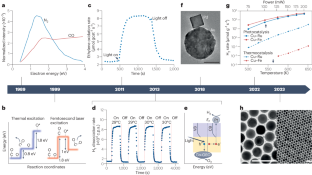
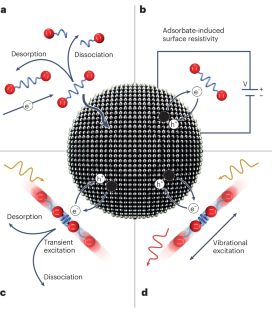
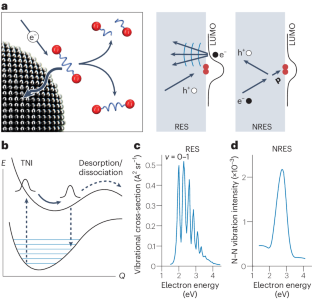
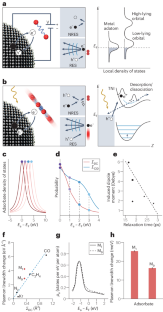
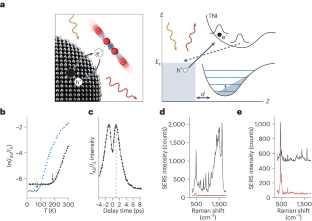
References
-
Plummer, E. W. & Gustafsson, T. Geometry of adsorbates on solid surfaces. Science 198, 165–170 (1977).
-
Smith, N. V. & Woodruff, D. P. Inverse photoemission from metal surfaces. Prog. Surf. Sci. 21, 295–370 (1986).
-
Woodruff, D. P. Fine structure in ionisation cross sections and applications to surface science. Rep. Prog. Phys. 49, 683 (1986).
-
Bertel, E. Unoccupied electronic states in adsorbate systems. Appl. Phys. A 53, 356–368 (1991).
-
Otto, A., Bornemann, T., Ertürk, Ü., Mrozek, I. & Pettenkofer, C. Model of electronically enhanced Raman scattering from adsorbates on cold-deposited silver. Surf. Sci. 210, 363–386 (1989).
-
Jacobi, K., Astaldi, C., Geng, P. & Bertolo, M. Physisorption of N2 and CO on Al(111): a combined HREELS-UPS investigation. Surf. Sci. 223, 569–577 (1989).
-
Hansen, W., Bertolo, M. & Jacobi, K. Physisorption of CO on Ag(111): investigation of the monolayer and the multilayer through HREELS, ARUPS, and TDS. Surf. Sci. 253, 1–12 (1991).
-
Bertolo, M., Hansen, W., Geng, P. & Jacobi, K. Resonance and dipole electron-scattering in physisorbed mono- and multilayers on Al(111) and Ag(111) surfaces. Surf. Sci. 251–252, 359–363 (1991).
-
Bonn, M. et al. Phonon- versus electron-mediated desorption and oxidation of CO on Ru(0001). Science 285, 1042–1045 (1999).
-
Mukherjee, S. et al. Hot-electron-induced dissociation of H2 on gold nanoparticles supported on SiO2. J. Am. Chem. Soc. 136, 64–67 (2014).
-
Christopher, P., Xin, H., Marimuthu, A. & Linic, S. Singular characteristics and unique chemical bond activation mechanisms of photocatalytic reactions on plasmonic nanostructures. Nat. Mater. 11, 1044–1050 (2012).
-
Landry, M. J., Gellé, A., Meng, B. Y., Barrett, C. J. & Moores, A. Surface-plasmon-mediated hydrogenation of carbonyls catalyzed by silver nanocubes under visible light. ACS Catal. 7, 6128–6133 (2017).
-
Kim, Y., Wilson, A. J. & Jain, P. K. The nature of plasmonically assisted hot-electron transfer in a donor–bridge–acceptor complex. ACS Catal. 7, 4360–4365 (2017).
-
Zhang, X. et al. Product selectivity in plasmonic photocatalysis for carbon dioxide hydrogenation. Nat. Commun. 8, 14542 (2017).
-
Oshikiri, T., Ueno, K. & Misawa, H. Plasmon-induced ammonia synthesis through nitrogen photofixation with visible light irradiation. Angew. Chem. Int. Ed. 53, 9802–9805 (2014).
-
Christopher, P., Xin, H. & Linic, S. Visible-light-enhanced catalytic oxidation reactions on plasmonic silver nanostructures. Nat. Chem. 3, 467–472 (2011).
-
Ezendam, S. et al. Hybrid plasmonic nanomaterials for hydrogen generation and carbon dioxide reduction. ACS Energy Lett. 7, 778–815 (2022).
-
Linic, S., Chavez, S. & Elias, R. Flow and extraction of energy and charge carriers in hybrid plasmonic nanostructures. Nat. Mater. 20, 916–924 (2021).
-
Herran, M. et al. Tailoring plasmonic bimetallic nanocatalysts toward sunlight-driven H2 production. Adv. Funct. Mater. 32, 2203418 (2022).
-
Khurgin, J. B. How to deal with the loss in plasmonics and metamaterials. Nat. Nanotechnol. 10, 2–6 (2015).
-
Khurgin, J. B. Ultimate limit of field confinement by surface plasmon polaritons. Faraday Discuss. 178, 109–122 (2015).
-
Foerster, B., Spata, V. A., Carter, E. A., Sönnichsen, C. & Link, S. Plasmon damping depends on the chemical nature of the nanoparticle interface. Sci. Adv. 5, eaav0704 (2019).
-
Persson, B. N. J. Polarizability of small spherical metal particles: influence of the matrix environment. Surf. Sci. 281, 153–162 (1993).
-
Hartland, G. V., Besteiro, L. V., Johns, P. & Govorov, A. O. What’s so hot about electrons in metal nanoparticles? ACS Energy Lett. 2, 1641–1653 (2017).
-
Kneipp, K. et al. Population pumping of excited vibrational states by spontaneous surface-enhanced Raman scattering. Phys. Rev. Lett. 76, 2444–2447 (1996).
-
Persson, B. N. J. Surface resistivity and vibrational damping in adsorbed layers. Phys. Rev. B 44, 3277–3296 (1991).
-
Gadzuk, J. W. Resonance-assisted, hot-electron-induced desorption. Surf. Sci. 342, 345–358 (1995).
-
Khurgin, J. B. Hot carriers generated by plasmons: where are they generated and where do they go from there? Faraday Discuss. 214, 35–58 (2019).
-
Gadzuk, J. W. & Šunjić, M. Electron scattering from molecules adsorbed on surfaces. AIP Conf. Proc. 204, 118–130 (1990).
-
Palmer, R. E. & Rous, P. J. Resonances in electron scattering by molecules on surfaces. Rev. Mod. Phys. 64, 383–440 (1992).
-
Teillet-Billy, D. & Gauyacq, J. P. Resonant electron scattering by molecules adsorbed on metal surfaces: angular aspects. Nucl. Instrum. Meth. B 101, 88–92 (1995).
-
Sanche, L. Low-energy electron scattering from molecules on surfaces. J. Phys. B 23, 1597–1624 (1990).
-
Bartolucci, F. & Franchy, R. EELS of negative-ion resonances: N2 films on Ag(110) at 15 K. Surf. Sci. 368, 27–37 (1996).
-
Berman, M., Estrada, H., Cederbaum, L. S. & Domcke, W. Nuclear dynamics in resonant electron-molecule scattering beyond the local approximation: the 2.3-eV shape resonance in N2. Phys. Rev. A 28, 1363–1381 (1983).
-
Herzenberg, A. Oscillatory energy dependence of resonant electron-molecule scattering. J. Phys. B 1, 548 (1968).
-
Avouris, P. & Demuth, J. Electron energy loss spectroscopy in the study of surfaces. Annu. Rev. Phys. Chem. 35, 49–73 (1984).
-
Avouris, P. & Persson, B. N. J. Excited states at metal surfaces and their non-radiative relaxation. J. Phys. Chem. 88, 837–848 (1984).
-
Newns, D. M. Self-consistent model of hydrogen chemisorption. Phys. Rev. 178, 1123–1135 (1969).
-
Otto, A. The ‘chemical’ (electronic) contribution to surface-enhanced Raman scattering. J. Raman Spectrosc. 36, 497–509 (2005).
-
Pinchuk, A. & Kreibig, U. Interface decay channel of particle surface plasmon resonance. N. J. Phys. 5, 151 (2003).
-
Lang, N. D. & Williams, A. R. Theory of atomic chemisorption on simple metals. Phys. Rev. B 18, 616–636 (1978).
-
Tobin, R. G. Mechanisms of adsorbate-induced surface resistivity––experimental and theoretical developments. Surf. Sci. 502-503, 374–387 (2002).
-
Grabhorn, H., Otto, A., Schumacher, D. & Persson, B. N. J. Variation of the DC-resistance of smooth and atomically rough silver films during exposure to C2H6 and C2H4. Surf. Sci. 264, 327–340 (1992).
-
Ke, Y. et al. Resistivity of thin Cu films with surface roughness. Phys. Rev. B 79, 155406 (2009).
-
Winkes, H., Schumacher, D. & Otto, A. Surface resistance measurements at the metal/electrolyte interface of Ag(100) and Ag(111) thin film electrodes. Surf. Sci. 400, 44–53 (1998).
-
Westcott, S. L., Averitt, R. D., Wolfgang, J. A., Nordlander, P. & Halas, N. J. Adsorbate-induced quenching of hot electrons in gold core−shell nanoparticles. J. Phys. Chem. B 105, 9913–9917 (2001).
-
Liu, C. & Tobin, R. G. Bonding-site dependence of surface resistivity: CO on epitaxial Cu(100) films. J. Chem. Phys. 126, 124705 (2007).
-
Holzapfel, C., Akemann, W., Schumacher, D. & Otto, A. Variations of DC-resistance and SERS intensity during exposure of cold-deposited silver films. Surf. Sci. 227, 123–128 (1990).
-
Ahmadi, K., Wu, D., Dole, N., Monteiro, O. R. & Brankovic, S. R. Tuning surface chemoresistivity of Au ultrathin films using metal deposition via surface-limited redox replacement of the underpotentially deposited Pb monolayer. ACS Sens. 4, 2442–2449 (2019).
-
Manjavacas, A., Liu, J. G., Kulkarni, V. & Nordlander, P. Plasmon-induced hot carriers in metallic nanoparticles. ACS Nano 8, 7630–7638 (2014).
-
Gallinet, B., Siegfried, T., Sigg, H., Nordlander, P. & Martin, O. J. F. Plasmonic radiance: probing structure at the Ångström scale with visible light. Nano Lett. 13, 497–503 (2013).
-
Liu, J. G., Zhang, H., Link, S. & Nordlander, P. Relaxation of plasmon-induced hot carriers. ACS Photon. 5, 2584–2595 (2018).
-
Wu, S. et al. The connection between plasmon decay dynamics and the surface enhanced Raman spectroscopy background: inelastic scattering from non-thermal and hot carriers. J. Appl. Phys. 129, 173103 (2021).
-
Beane, G., Brown, B. S., Devkota, T. & Hartland, G. V. Light-like group velocities and long lifetimes for leaky surface plasmon polaritons in noble metal nanostripes. J. Phys. Chem. C 123, 15729–15737 (2019).
-
Kreibig, U. & Vollmer, M. in Optical Properties of Metal Clusters (eds Kreibig, U. & Vollmer, M.) 13–201 (Springer, 1995).
-
Kreibig, U. & Vollmer, M. in Optical Properties of Metal Clusters (eds Kreibig, U. & Vollmer, M.) 275–436 (Springer, 1995).
-
Hövel, H., Fritz, S., Hilger, A., Kreibig, U. & Vollmer, M. Width of cluster plasmon resonances: bulk dielectric functions and chemical interface damping. Phys. Rev. B 48, 18178–18188 (1993).
-
Khurgin, J. B., Petrov, A., Eich, M. & Uskov, A. V. Direct plasmonic excitation of the hybridized surface states in metal nanoparticles. ACS Photon. 8, 2041–2049 (2021).
-
Chang, E. S., Antoni, Th., Jung, K. & Ehrhardt, H. Coherent resonance and dipole scattering in rotational excitation of molecules by slow electrons. Phys. Rev. A 30, 2086–2088 (1984).
-
Kim, Y., Ji, S. & Nam, J.-M. A chemist’s view on electronic and steric effects of surface ligands on plasmonic metal nanostructures. Acc. Chem. Res. 56, 2139–2150 (2023).
-
Kazuma, E., Jung, J., Ueba, H., Trenary, M. & Kim, Y. Real-space and real-time observation of a plasmon-induced chemical reaction of a single molecule. Science 360, 521–526 (2018).
-
Oksenberg, E. et al. Energy-resolved plasmonic chemistry in individual nanoreactors. Nat. Nanotechnol. 16, 1378–1385 (2021).
-
Dong, Y., Hu, C., Xiong, H., Long, R. & Xiong, Y. Plasmonic catalysis: new opportunity for selective chemical bond evolution. ACS Catal. 13, 6730–6743 (2023).
-
Kiani, F. et al. Transport and interfacial injection of d-band hot holes control plasmonic chemistry. ACS Energy Lett. 8, 4242–4250 (2023).
-
Wu, K., Chen, J., McBride, J. R. & Lian, T. Efficient hot-electron transfer by a plasmon-induced interfacial charge-transfer transition. Science 349, 632–635 (2015).
-
Hou, B., Thoss, M., Banin, U. & Rabani, E. Incoherent nonadiabatic to coherent adiabatic transition of electron transfer in colloidal quantum dot molecules. Nat. Commun. 14, 3073 (2023).
-
Zhang, Q. et al. Real-time observation of two distinctive non-thermalized hot electron dynamics at MXene/molecule interfaces. Nat. Commun. 15, 4406 (2024).
-
Petek, H. Photoexcitation of adsorbates on metal surfaces: One-step or three-step. J. Chem. Phys. 137, 091704 (2012).
-
De Sio, A. & Lienau, C. Vibronic coupling in organic semiconductors for photovoltaics. Phys. Chem. Chem. Phys. 19, 18813–18830 (2017).
-
Collini, E. et al. Coherently wired light-harvesting in photosynthetic marine algae at ambient temperature. Nature 463, 644–647 (2010).
-
Wang, S., Scholes, G. D. & Hsu, L.-Y. Coherent-to-incoherent transition of molecular fluorescence controlled by surface plasmon polaritons. J. Phys. Chem. Lett. 11, 5948–5955 (2020).
-
Kato, T., Tanaka, T., Yajima, T. & Uchida, K. Temperature dependence of resistivity increases induced by thiols adsorption in gold nanosheets. Jpn. J. Appl. Phys. 60, SBBH13 (2021).
-
Brown, B. S. & Hartland, G. V. Chemical interface damping for propagating surface plasmon polaritons in gold nanostripes. J. Chem. Phys. 152, 024707 (2020).
-
Stefancu, A. et al. Halide–metal complexes at plasmonic interfaces create new decay pathways for plasmons and excited molecules. ACS Photon. 9, 895–904 (2022).
-
Langer, J. et al. Present and future of surface-enhanced Raman scattering. ACS Nano 14, 28–117 (2020).
-
Schürmann, R. et al. Microscopic understanding of reaction rates observed in plasmon chemistry of nanoparticle–ligand systems. J. Phys. Chem. C 126, 5333–5342 (2022).
-
Kogikoski, S. Jr., Dutta, A. & Bald, I. Spatial separation of plasmonic hot-electron generation and a hydrodehalogenation reaction center using a DNA wire. ACS Nano 15, 20562–20573 (2021).
-
Stefancu, A. et al. Fermi level equilibration at the metal–molecule interface in plasmonic systems. Nano Lett. 21, 6592–6599 (2021).
-
Le Ru, E. & Etchegoin, P. G. Principles of Surface-Enhanced Raman Spectroscopy and Related Plasmonic Effects (Elsevier, 2009).
-
Neuman, T., Aizpurua, J. & Esteban, R. Quantum theory of surface-enhanced resonant Raman scattering (SERRS) of molecules in strongly coupled plasmon–exciton systems. Nanophotonics, 9, 295–308 (2020).
-
Neuman, T., Esteban, R., Giedke, G., Schmidt, M. K. & Aizpurua, J. Quantum description of surface-enhanced resonant Raman scattering within a hybrid-optomechanical model. Phys. Rev. A 100, 043422 (2019).
-
Li, P. et al. Investigation of charge-transfer between a 4-mercaptobenzoic acid monolayer and TiO2 nanoparticles under high pressure using surface-enhanced Raman scattering. Chem. Commun. 54, 6280–6283 (2018).
-
Wang, X. et al. Reduced charge-transfer threshold in dye-sensitized solar cells with an Au@Ag/N3/n-TiO2 structure as revealed by surface-enhanced Raman scattering. J. Phys. Chem. C 122, 12748–12760 (2018).
-
Lindquist, N. C., de Albuquerque, C. D. L., Sobral-Filho, R. G., Paci, I. & Brolo, A. G. High-speed imaging of surface-enhanced Raman scattering fluctuations from individual nanoparticles. Nat. Nanotechnol. 14, 981–987 (2019).
-
Almehmadi, L. M., Curley, S. M., Tokranova, N. A., Tenenbaum, S. A. & Lednev, I. K. Surface enhanced Raman spectroscopy for single molecule protein detection. Sci. Rep. 9, 12356 (2019).
-
Le Ru, E. C. & Etchegoin, P. G. Vibrational pumping and heating under SERS conditions: fact or myth? Faraday Discuss. 132, 63–75 (2006).
-
Kozich, V. & Werncke, W. The vibrational pumping mechanism in surface-enhanced Raman scattering: a subpicosecond time-resolved study. J. Phys. Chem. C 114, 10484–10488 (2010).
-
Boerigter, C., Aslam, U. & Linic, S. Mechanism of charge transfer from plasmonic nanostructures to chemically attached materials. ACS Nano 10, 6108–6115 (2016).
-
Boerigter, C., Campana, R., Morabito, M. & Linic, S. Evidence and implications of direct charge excitation as the dominant mechanism in plasmon-mediated photocatalysis. Nat. Commun. 7, 10545 (2016).
-
Fojt, J., Rossi, T. P., Kuisma, M. & Erhart, P. Hot-carrier transfer across a nanoparticle–molecule junction: the importance of orbital hybridization and level alignment. Nano Lett. 22, 8786–8792 (2022).
-
Reddy, H. et al. Determining plasmonic hot-carrier energy distributions via single-molecule transport measurements. Science 369, 423–426 (2020).
-
Huang, P. & Carter, E. A. Self-consistent embedding theory for locally correlated configuration interaction wave functions in condensed matter. J. Chem. Phys. 125, 084102 (2006).
-
Sundararaman, R., Narang, P., Jermyn, A. S., Goddard Iii, W. A. & Atwater, H. A. Theoretical predictions for hot-carrier generation from surface plasmon decay. Nat. Commun. 5, 5788 (2014).
-
Jermyn, A. S. et al. Transport of hot carriers in plasmonic nanostructures. Phys. Rev. Mater. 3, 075201 (2019).
-
Vanzan, M., Gil, G., Castaldo, D., Nordlander, P. & Corni, S. Energy transfer to molecular adsorbates by transient hot electron spillover. Nano Lett. 23, 2719–2725 (2023).
-
João, S. M., Jin, H. & Lischner, J. C. Atomistic theory of hot-carrier relaxation in large plasmonic nanoparticles. J. Phys. Chem. C 127, 23296–23302 (2023).
-
Wu, S., Chen, Y. & Gao, S. Plasmonic photocatalysis with nonthermalized hot carriers. Phys. Rev. Lett. 129, 086801 (2022).
-
Cushing, S. K. et al. Tunable nonthermal distribution of hot electrons in a semiconductor injected from a plasmonic gold nanostructure. ACS Nano 12, 7117–7126 (2018).
-
Habib, A., Lubbers, N., Tretiak, S. & Nebgen, B. Machine learning models capture plasmon dynamics in Ag nanoparticles. J. Phys. Chem. A 127, 3768–3778 (2023).
-
Ko, T. W., Finkler, J. A., Goedecker, S. & Behler, J. A fourth-generation high-dimensional neural network potential with accurate electrostatics including non-local charge transfer. Nat. Commun. 12, 398 (2021).
-
Seemala, B. et al. Plasmon-mediated catalytic O2 dissociation on Ag nanostructures: hot electrons or near fields? ACS Energy Lett. 4, 1803–1809 (2019).
-
Philpott, M. R. Effect of surface plasmons on transitions in molecules. J. Chem. Phys. 62, 1812–1817 (1975).
-
Liu, G. L., Long, Y.-T., Choi, Y., Kang, T. & Lee, L. P. Quantized plasmon quenching dips nanospectroscopy via plasmon resonance energy transfer. Nat. Methods 4, 1015–1017 (2007).
-
Collins, S. S. E. et al. Plasmon energy transfer in hybrid nanoantennas. ACS Nano. 15, 9522–9530 (2021).
-
Vijay, S. et al. Dipole-field interactions determine the CO2 reduction activity of 2D Fe–N–C single-atom catalysts. ACS Catal. 10, 7826–7835 (2020).
-
Vijay, S. et al. Unified mechanistic understanding of CO2 reduction to CO on transition metal and single atom catalysts. Nat. Catal. 4, 1024–1031 (2021).
-
Chan, K. A few basic concepts in electrochemical carbon dioxide reduction. Nat. Commun. 11, 5954 (2020).
-
Ringe, S. et al. Double layer charging driven carbon dioxide adsorption limits the rate of electrochemical carbon dioxide reduction on gold. Nat. Commun. 11, 33 (2020).
-
Cai, C. et al. Atomically local electric field induced interface water reorientation for alkaline hydrogen evolution reaction. Angew. Chem. Int. Ed. 62, e202300873 (2023).
-
Corson, E. R. et al. In situ ATR–SEIRAS of carbon dioxide reduction at a plasmonic silver cathode. J. Am. Chem. Soc. 142, 11750–11762 (2020).
-
Landaeta, E., Kadosh, N. I. & Schultz, Z. D. Mechanistic study of plasmon-assisted in situ photoelectrochemical CO2 reduction to acetate with a Ag/Cu2O nanodendrite electrode. ACS Catal. 13, 1638–1648 (2023).
-
Ward, D. R., Hüser, F., Pauly, F., Cuevas, J. C. & Natelson, D. Optical rectification and field enhancement in a plasmonic nanogap. Nat. Nanotechnol. 5, 732–736 (2010).
-
Nelson, D. A. & Schultz, Z. D. The impact of optically rectified fields on plasmonic electrocatalysis. Faraday Discuss. 214, 465–477 (2019).
-
Ren, W., Xu, A., Chan, K. & Hu, X. A cation concentration gradient approach to tune the selectivity and activity of CO2 electroreduction. Angew. Chem. Int. Ed. 61, e202214173 (2022).
-
Peiris, E. et al. Plasmonic switching of the reaction pathway: visible-light irradiation varies the reactant concentration at the solid–solution interface of a gold–cobalt catalyst. Angew. Chem. Int. Ed. 58, 12032–12036 (2019).
-
Han, P. et al. Promoting Ni(II) catalysis with plasmonic antennas. Chem 5, 2879–2899 (2019).
-
Saalfrank, P. Photodesorption of neutrals from metal surfaces: a wave packet study. Chem. Phys. 193, 119–139 (1995).
-
Herran, M. et al. Plasmonic bimetallic two-dimensional supercrystals for H2 generation. Nat. Catal. 6, 1205–1214 (2023).
-
Mukherjee, S. et al. Hot electrons do the impossible: plasmon-induced dissociation of H2 on Au. Nano Lett. 13, 240–247 (2013).
-
Mubeen, S. et al. An autonomous photosynthetic device in which all charge carriers derive from surface plasmons. Nat. Nanotechnol. 8, 247–251 (2013).
-
Vadai, M., Angell, D. K., Hayee, F., Sytwu, K. & Dionne, J. A. In-situ observation of plasmon-controlled photocatalytic dehydrogenation of individual palladium nanoparticles. Nat. Commun. 9, 4658 (2018).
-
Yuan, Y. et al. Earth-abundant photocatalyst for H2 generation from NH3 with light-emitting diode illumination. Science 378, 889–893 (2022).
-
Maher, R. C., Galloway, C. M., Le Ru, E. C., Cohen, L. F. & Etchegoin, P. G. Vibrational pumping in surface enhanced Raman scattering (SERS). Chem. Soc. Rev. 37, 965–979 (2008).
-
Otto, A. Theory of first layer and single molecule surface enhanced Raman scattering (SERS). Phys. Stat. Solidi A 188, 1455–1470 (2001).
-
Otto, A., Akemann, W. & Pucci, A. Normal bands in surface-enhanced Raman scattering (SERS) and their relation to the electron-hole pair excitation background in SERS. Isr. J. Chem. 46, 307–315 (2006).
-
Wu, S. et al. The connection between plasmon decay dynamics and the surface enhanced Raman spectroscopy background: Inelastic scattering from non-thermal and hot carriers. J. Appl. Phys. 129, 173103 (2021).
-
Zhu, Y., Natelson, D. & Cui, L. Probing energy dissipation in molecular-scale junctions via surface enhanced Raman spectroscopy: vibrational pumping and hot carrier enhanced light emission. J. Phys. Condens. Matter 33, 134001 (2021).
-
Bayle, M. et al. Experimental investigation of the vibrational density of states and electronic excitations in metallic nanocrystals. Phys. Rev. B 89, 195402 (2014).
-
Zangwill, A. Physics at Surfaces (Cambridge Univ. Press, 1988).
-
Avouris, P., Lyo, I. W. & Molinàs-Mata, P. STM studies of the interaction of surface state electrons on metals with steps and adsorbates. Chem. Phys. Lett. 240, 423–428 (1995).
-
Koch, E. E., Barth, J., Fock, J. H., Goldmann, A. & Otto, A. Surface photoemission in the 4d band from polycrystalline silver surfaces. Solid State Commun. 42, 897–901 (1982).
Acknowledgements
We acknowledge funding and support from the Deutsche Forschungsgemeinschaft (DFG) under Germany´s Excellence Strategy—grant number EXC 2089/1—390776260 e-conversion excellence research cluster, the Bavarian programme Solar Technologies Go Hybrid (SolTech), the Center for NanoScience (CeNS) and the European Commission through the ERC Starting Grant CATALIGHT (grant number 802989). A.S. acknowledges support from the Alexander von Humboldt foundation. P.N. and N.J.H. acknowledge support from the Robert A. Welch Foundation under grant numbers C-1222 and C-1220. N.J.H., P.N. and E.C. acknowledge the Institute for Advanced Study (IAS) from Technische Universität München (TUM) for financing the focus group on ‘Sustainable photocatalysis using plasmons and 2D materials (SusPhuP2M)’ as part of the Hans Fisher Senior Fellowships programme. We thank J. Knott for assistance with the figures.
Author information
Authors and Affiliations
Contributions
All authors contributed equally to all aspects of the Review.
Corresponding author
Ethics declarations
Competing interests
The authors declare no competing interests.
Peer review
Peer review information
Nature Physics thanks Jennifer Dionne and the other, anonymous, reviewer(s) for their contribution to the peer review of this work.
Additional information
Publisher’s note Springer Nature remains neutral with regard to jurisdictional claims in published maps and institutional affiliations.
Rights and permissions
Springer Nature or its licensor (e.g. a society or other partner) holds exclusive rights to this article under a publishing agreement with the author(s) or other rightsholder(s); author self-archiving of the accepted manuscript version of this article is solely governed by the terms of such publishing agreement and applicable law.
About this article
Cite this article
Stefancu, A., Halas, N.J., Nordlander, P. et al. Electronic excitations at the plasmon–molecule interface. Nat. Phys. (2024). https://ift.tt/poyWhdt
-
Received:
-
Accepted:
-
Published:
-
DOI: https://ift.tt/poyWhdt
"interface" - Google News
July 15, 2024 at 04:15PM
https://ift.tt/RrlTcE5
Electronic excitations at the plasmon–molecule interface - Nature.com
"interface" - Google News
https://ift.tt/V1vi0M2
https://ift.tt/2PBqMxn
Bagikan Berita Ini














0 Response to "Electronic excitations at the plasmon–molecule interface - Nature.com"
Post a Comment